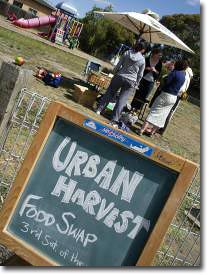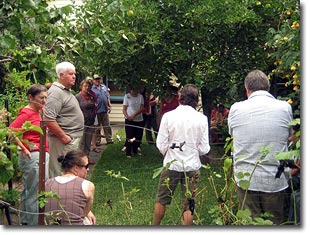Here is a link to an article to wrote for the Permaculture Research Institute of Australia
http://permaculturenews.org/author/Karen%20Sutherland
In the Transition to Self-sufficiency, Suburban Food Gardens Have a Role to Play
2009 by Karen Sutherland
In all my 25 years gardening and landscaping, I’ve never seen anything like the interest in food gardening of the last year or so.
About 18 months ago I changed the focus of my gardening and landscaping business from ‘ordinary’ gardening to produce gardening, and started Edible Eden Design. I had realized that I was happiest working with edible plants and decided to try to make them the focus of my work. I wanted (amongst other things) to promote the idea of using edible plants in an ornamental way. I had no idea at the time the changes that were happening in society and the interest it would generate.
Since then I’ve been on National Radio and TV, all due to the interest in home food gardening.
I have been designing and installing gardens for 20 or more years, and in that time maybe 10% of my clients have wanted something edible in their gardens. Perhaps a couple of fruit trees and a tiny vegie patch. I’ve always slipped a Rosemary ‘Blue Lagoon’ into everyone’s garden, explaining that, yes, you can cook with it and its sky blue flowers not only feed bees but brighten the garden.
About a year ago that 10% became the ones who didn’t want anything edible. Now I’m designing whole gardens with edible plants to appear indiscernible from other ornamental landscapes in garden-conscious Melbourne. The public has embraced the concept of food gardening wholeheartedly.
To help show what can be grown in a suburban or city garden, I have opened up my home garden, with its 150 or more edible plants, to classes and open days. In my classes I try to give students the confidence to grow what they can, no matter what size garden they have, in soil or pots. If they see various edible plants growing in my garden they can imagine growing them at home, and seeing how plants fare in various situations teaches the range of situations they tolerate. Suburban gardens often have less than perfect conditions for growing food plants, and I like to show what is possible despite this.
I try to give them the whole picture, so we eat food made with ingredients from my garden, we sample fruit from the garden in season and they leave with vegetable or herb seeds collected from my garden.
Meanwhile, in April 2008 the NIAV (Nursery Industry Association of Victoria) reported a huge shift in buying habits of the nursery going public. (This is still continuing in 2009, with nurseries reporting increases in sales of vegetable seedlings and fruit trees even as other plant sales decline with the harder economic times). This was in line with reports from the USA and UK. In the US, the National Gardening Association reported $US1.4 billion spent on vegetable growing in 2007, an increase of 25% on 2006. In the UK, sales of fruit trees and seeds of edible plants were up 13% in 2006 and 43% in 2007.
These reports piqued the interest of the Bush Telegraph programme on Radio National, and I was asked to be a guest to discuss these changes and my observations of them. There was so much interest they invited me back on a subsequent occasion. Home food growing had become news.
Fast forward to April 2009 and current affairs programme ’60 Minutes’ included my garden and I in a segment called ‘Backyard Revolution‘. I was fairly amazed when they called me, as anyone who has seen ’60 Minutes’ would understand that unless they thought this was of interest to the general public of Australia; they would not run the story.
The segment described how the Australian public was enthusiastically learning to grow their own food, from the school children of the Stephanie Alexander Kitchen Garden Programme, to the community gardeners of inner city Melbourne, aided ably by the grandfather of vegetable gardening, Peter Cundall, and a gardener in inner suburban Melbourne. (!)
The 60 Minutes cameraman told me his own front garden was devoted to fruit and vegetables, and the whole film team that came was highly receptive and interested in the idea. I was their web guest afterwards, so spent an hour or so answering questions emailed in, from all over Australia. That night I watched as my email box filled up with questions and class bookings. The next home gardening class I was due to run was quickly booked up – I ended up running that class 5 times in 10 days, to cater for the demand. I now have a waiting list for all my classes.
Since 2007, more than 50% of the world’s population now lives in cities (1). In Australia, 80% of us live in cities. Given these figures, suburban food gardening takes on a whole new significance.
Not everyone has access to land in the country to grow all their own food, but surprisingly large amounts of food can be grown on the large tracts of land still unused in our cities. Digger’s Nursery at Dromana, Victoria says that we need around 10m2 to grow each person’s food and many suburban gardens have more than this available. Urban food swaps can fill gaps that we may have in our capacity to grow our own food. Many food plants can be grown in pots on balconies or apartment windowsills.
The food we eat may contribute up to 30% of our carbon footprint, with a lot of this due to transporting the food over long distances and its subsequent need for refrigeration. Growing food where we live can substantially reduce our impact on the earth. Food harvested just before eating is far more nutritious than food carried long distances, and small food allotments are able to have their pests and diseases more easily managed without harmful chemicals. Home grown food may require 1/17th of the need for watering as commercially grown food (2) – of vital importance as some parts of Australia experience perhaps the worst drought in recorded history. Prominent public figures are setting the example – the Obamas and the Queen have installed vegetable gardens, our prime minister has yet to follow!
Large companies have picked up on the shift in public sentiment.
I watched a TV commercial recently where wide-eyed children cuddled chickens and harvested eggs, an apartment dweller picked fresh herbs from a window-box over a city laneway and neighbours handed home-grown vegetables over the fence. Our new warm feeling about growing our own food was being hijacked by ‘the fresh food people’!
My local large hardware store starting with B has an expanded stand of vegetable seeds, showing that they too have done their market research.
Not that long ago, my older European descent neighbours lamented to me that none of their children wanted to learn the vegetable and fruit growing skills that they had brought from the villages they grew up in. Now everywhere I turn, there is a great hunger for that knowledge, to learn how to grow, cook and preserve our own food.
Every magazine I pick up has articles on home food growing and self-sufficiency, from starting a herb patch to keeping chickens.
The enthusiasm my students have for learning how to grow and use their own food, gives me hope for the future!
References:
- United Nations, “World Urbanization Prospects – The 2007 Revision”
- David Holmgren, from Lenzan and Foran reports 2001 and 2005






Recent Comments